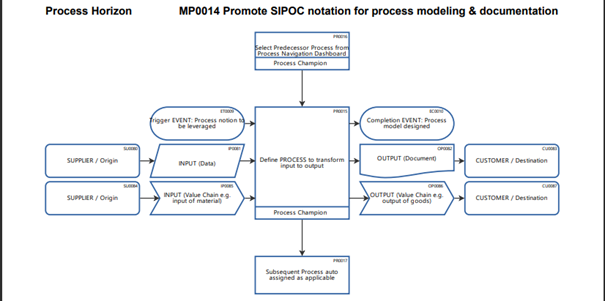Why is the SIPOC process modeling methodology well suited for business professionals ?

The SIPOC methodology and the incremental Business Process Model and notation is a simple and straightforward but versatile process modeling technique that focuses on the high-level view of a process, including the inputs, outputs, and stakeholders involved.
Transformation of input from origin via a process to output to destination as modeled by the SIPOC notation:
Suppliers > Inputs > PROCESS > Outputs > Customers
SIPOC is thus well suited for professionals who need a quick and easy way to capture the key components of a process and identify areas for improvement. The SIPOC methodology can be useful for comprehensive process mapping, identifying process boundaries, and defining the scope of an organization or project.
Process improvement is about rethinking and redesigning core business processes from scratch, using a customer-focused and cross-functional perspective. This can involve eliminating unnecessary steps, reducing bureaucracy, and leveraging technology to automate and streamline processes.
Key notions of business process modeling and management supported by the SIPOC methodology:
- Business Process: A set of activities or tasks performed by one or more stakeholders to achieve a specific goal or outcome.
- Business Process Modeling: The act of creating a visual representation of a business process using diagrams, symbols, and notation.
- Process Mapping: A technique for visualizing and documenting the steps and sequence of activities in a business process.
- Process Improvement: The act of analyzing and making changes to a business process in order to improve its efficiency, effectiveness, or quality.
- Business Process Management (BPM): The discipline of managing and improving business processes throughout an organization.
- Process Automation: The use of technology to automate repetitive or manual tasks in a business process.
- Key Performance Indicators (KPIs): Process Governance metrics used to measure the performance of a business process and identify areas for improvement.
- Workflow: The flow of tasks or activities within a business process, including their sequence, timing, and dependencies.
- Process Standardization & ProcessTransparency: The process of establishing consistent and repeatable processes across an organization.
- Process Optimization: The process of refining a business process to make it more efficient, effective, and aligned with the organization's goals.
- Process Innovation: can transform your business
Improve the efficiency and effectiveness of your business processes with the help of the smart interactive ProcessHorizon web app with automated SIPOC design intelligence empowering professionals to take control of their vital processes.



